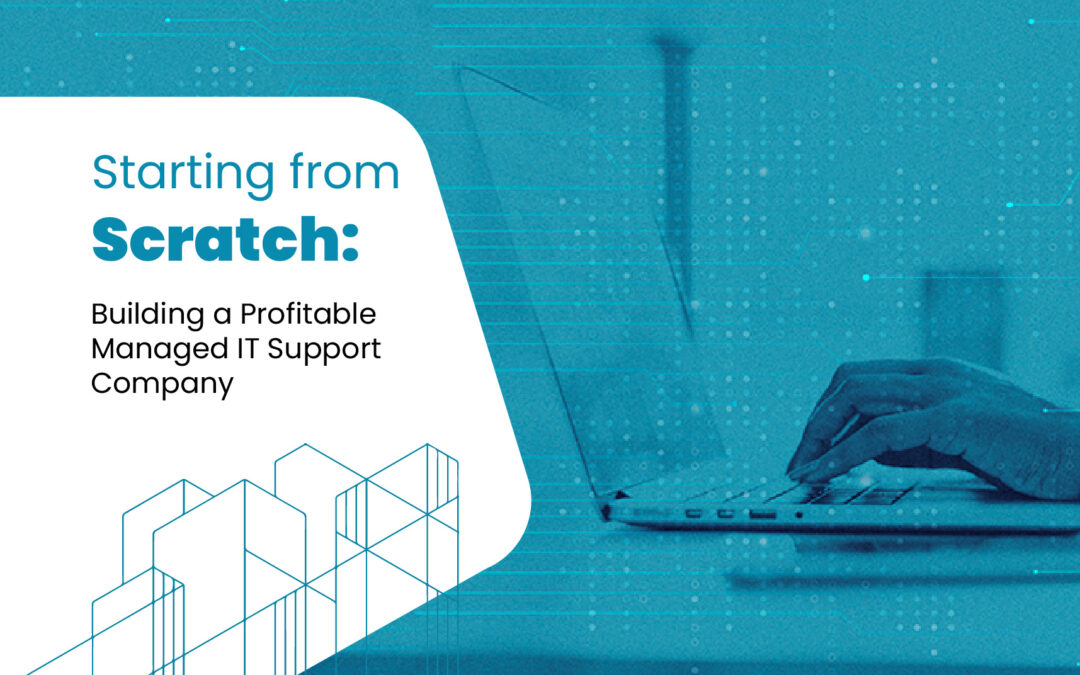Embarking on the journey of starting a small business in the realm of managed IT support presents a unique blend of challenges and opportunities in today’s technology-driven market. This venture requires not just a grasp of the intricate and ever-evolving world of information technology but also an entrepreneurial zeal that embraces the nuances of building a business from the ground up. Managed IT support, a sector that has become increasingly indispensable for businesses across various industries, offers a promising avenue for aspiring entrepreneurs to make their mark. This article aims to guide those at the cusp of this entrepreneurial path, providing insights and strategies for establishing a successful managed IT support company.
Understanding Managed IT Support
Managed IT support has become a pivotal element in the modern business landscape, offering tailored technological solutions to companies of all sizes. This section explores the nuances of managed IT support, its importance in today’s business world, and the diverse services it encompasses.
The Essence of Managed IT Support
At its core, managed IT support involves outsourcing various technology-related tasks and functions to a specialized service provider. This arrangement allows businesses to focus on their core activities while ensuring their IT infrastructure is managed efficiently and effectively. Managed IT support covers a broad spectrum of services, from basic IT support to complex cybersecurity measures, providing businesses with a comprehensive approach to managing their technological needs.
Why Businesses Need Managed IT Support
In an era of rapid technological advancement, keeping up with the latest IT trends and security measures can be overwhelming for many businesses, especially small to medium-sized enterprises. Managed IT support steps in to fill this gap by offering expert services that ensure seamless operation of IT systems. This not only enhances operational efficiency but also reduces the risk of downtime and cyber threats, which are crucial for maintaining a competitive edge in today’s market.
Services Offered in Managed IT Support
Managed IT support encompasses a range of services, each designed to address specific aspects of a company’s IT needs. Common services include:
Network Management: Ensuring that the company’s network infrastructure is robust, secure, and efficient.
Data Backup and Recovery: Implementing solutions to protect data and restore it in case of loss or damage.
Cybersecurity Measures: Protecting the business from cyber threats with up-to-date security protocols.
Cloud Services: Managing and supporting cloud computing solutions which include storage, software, and processing power.
Hardware and Software Management: Overseeing the installation, maintenance, and updating of IT hardware and software.
Helpdesk Support: Providing employees with immediate assistance for any IT-related issues.
Customized Solutions for Diverse Needs
One of the key strengths of managed IT support is its ability to offer customized solutions tailored to the specific needs of each business. Providers work closely with clients to understand their unique challenges and objectives, crafting a service package that aligns with their goals and budget. This bespoke approach not only ensures that businesses get the most out of their IT infrastructure but also fosters a partnership that can adapt and evolve as the business grows.
Step 1: Do Market Research and Identify Your Niche
The initial and perhaps most critical step in starting your managed IT support business is conducting thorough market research and identifying a specific niche that aligns with your expertise and market needs. This process involves a deep dive into understanding the current landscape of the IT support sector, identifying potential client bases, and analysing what competitors are offering. This not only helps in pinpointing gaps in the market that your business can fill but also in tailoring your services to meet unique demands. For instance, you might discover a demand for cloud integration services in small businesses or a lack of comprehensive cybersecurity solutions in a particular industry. By focusing on a niche, you can concentrate your efforts on becoming a specialist in that area, thereby differentiating your business in a competitive market.
Step 2: Developing a Business Plan
Crafting a thorough business plan is a fundamental step in setting up a successful managed IT support company. This comprehensive document should serve as a roadmap, outlining your vision, objectives, and the strategies you intend to employ to achieve them. It must encompass a detailed market analysis, highlighting the demand for managed IT services, potential competition, and identifying your target audience. An integral part of the plan is a clear outline of your service offerings, including any unique aspects that set your business apart in a crowded market. Financial planning is also crucial, covering startup costs, pricing strategy, revenue projections, and a break-even analysis.
Step 3: Legal and Financial Considerations
Embarking on the journey of establishing your managed IT support business requires meticulous attention to legal and financial considerations, an essential step in developing entrepreneurial spirit. This process begins with registering your business, a critical legal formality that gives your venture a formal structure and identity. Choosing the right business structure – be it sole proprietorship, partnership, or limited company – is crucial as it has significant implications for tax, liability, and the way you report your business to the authorities.
Next, obtaining the necessary licenses and permits ensures your business operates within the legal framework, which is particularly important in the IT sector where compliance and data protection are paramount. Setting up a dedicated business bank account is not only a best practice for financial management but also enhances your company’s professionalism. Securing initial funding, whether through loans, investors, or personal savings, requires a well-prepared financial plan that outlines your expected revenue streams, start-up costs, and budgeting strategies. Addressing these legal and financial aspects not only lays a solid foundation for your business but also instills confidence, a key aspect of developing entrepreneurial spirit.
Step 4: Building Your Team
In building a team for your managed IT support business, it is crucial to find individuals who not only possess technical expertise but also align with the customer service ethos of your company, fostering a culture that embodies the developing entrepreneurial spirit. A competent team is the lifeblood of your business, as their skills and dedication directly impact the quality of service delivered to clients. Investing in their continuous training and development is vital to ensure they stay abreast of the latest technological advancements and industry best practices.
This commitment to professional growth not only enhances your service quality but also motivates your team, creating a work environment that values knowledge and excellence. Cultivating a team that is not just technically proficient but also passionate about delivering top-tier IT solutions is instrumental in building a reputation for quality and reliability, key factors in the success of any entrepreneurial venture in the managed IT support sector.
Step 5: Setting Up Your Infrastructure
Establishing a robust IT infrastructure is a pivotal step in the journey of developing a successful managed IT support business, reflecting the developing entrepreneurial spirit. This infrastructure encompasses both tangible assets like hardware and office space, and intangible elements such as software and cloud services. Investing in high-quality, scalable technology solutions from the beginning can significantly reduce future costs and prevent operational hiccups as your business expands. The choice of technology should be guided by both current needs and future scalability, ensuring that your infrastructure can grow seamlessly with your business.
Step 6: Marketing and Client Acquisition
Effective marketing and client acquisition strategies are the lifeblood of any new business, especially in the competitive field of managed IT support. Developing entrepreneurial spirit involves not just understanding your service offerings but also mastering the art of communicating them to your target audience. A well-crafted marketing strategy should encompass both digital and traditional methods. Building a professional website, engaging in search engine optimization (SEO), and maintaining an active presence on social media are essential to reach a wider audience and establish your brand online. Offline tactics like attending industry events, networking, and word-of-mouth referrals are equally important in building relationships and gaining trust. Utilizing client testimonials and case studies effectively showcases your expertise and the tangible benefits you provide, helping to build credibility and trust with potential clients.
Step 7: Delivering Exceptional Service
The cornerstone of a successful managed IT support business is the unwavering commitment to delivering exceptional service. This involves not only addressing and resolving technical issues efficiently but also proactively identifying and mitigating potential problems before they impact your clients. Developing a strong entrepreneurial spirit in this field means cultivating a customer-focused culture within your company, where every team member understands the value of maintaining clear and consistent communication with clients. Responsiveness to client needs, adaptability to changing technologies, and the ability to provide personalized solutions are essential traits that set your business apart.
Regularly soliciting feedback, being open to constructive criticism, and continuously improving your service offerings are key practices that demonstrate your dedication to client satisfaction. By consistently delivering high-quality, reliable IT support, you establish a reputation of excellence and trustworthiness, which is paramount in retaining clients and fostering long-term business relationships in the competitive landscape of managed IT support.
Conclusion
In conclusion, establishing a successful managed IT support company is a multifaceted endeavor that requires careful planning, legal and financial diligence, team building, robust infrastructure development, effective marketing strategies, and an unwavering commitment to exceptional service. Each step, from understanding the market dynamics to consistently delivering top-notch IT solutions, is crucial in carving out a niche in this competitive sector. The journey of developing an entrepreneurial spirit in the world of managed IT support is challenging yet rewarding, offering immense potential for growth and innovation. As technology continues to evolve and businesses increasingly rely on digital solutions, the demand for managed IT services is set to grow, presenting ongoing opportunities for success and expansion.













